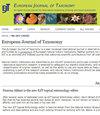A new species of Liolaemus (Iguania: Liolaemidae) from the hot deserts of northern Patagonia, Argentina
IF 1.3
3区 生物学
Q3 ENTOMOLOGY
引用次数: 0
Abstract
A new species of Liolaemus is described from southwest of the town of Añelo, Neuquén Province, Argentina. Integrative evidence methodology of external morphological characters and molecular phylogenetic analyses of mitochondrial DNA (cyt-b) is used to place the new species to the species group of Liolaemus boulengeri. The new species is phenotypically close to L. mapuche. The new Liolaemus is medium to large in size (males 77.64–83.98 mm, females 72.88–78.58 mm), with evident sexual dichromatism. Genetic distances of the mtDNA (cyt-b) between the new species and its closest relative species are greater than 3% (L. cuyanus 7.48–12.02%; L. josei 7.56–9.60%; L. puelche 8.23–9.93%; L. mapuche 8.51–9.79%). Molecular and morphological phylogenetic results show L. mapuche as the sister species of the new one. The new species is larger than L. mapuche. Dorsal and ventral scales are more numerous in the new species than in L. mapuche, precloacal pores in females are present in L. mapuche and absent in the new species. It has strict psammophilic habits, using sand mounds and sheltering, under Alpataco (Neltuma alpataco) bushes. The L. boulengeri group now contains 75 species distributed in Argentina, Bolivia, Brazil, Chile, Paraguay, Peru and Uruguay.标题阿根廷巴塔哥尼亚北部热沙漠蝗属一新种(鬣蜥纲:蝗科)
在阿根廷诺伊肯省阿尼埃洛镇西南部,描述了一种新的Liolaemus。利用线粒体DNA(cyt-b)的外部形态特征和分子系统发育分析的综合证据方法,将该新种归入博氏梨属物种群。该新种在表型上接近L.mapuche。新的Liolaemus体型中等至较大(雄性77.64–83.98毫米,雌性72.88–78.58毫米),具有明显的两性二色性。新物种与其近缘种之间的mtDNA(cyt-b)遗传距离大于3%(L.cuyanus 7.48–12.02%;L.josei 7.56–9.60%;L.puelche 8.23–9.93%;L.mapuche 8.51–9.79%)。新种的背鳞和腹鳞比马普切的多,雌性的盲肠前孔在马普切中存在,而在新种中不存在。它有严格的喜沙生习性,使用沙堆并在Alpataco(Neltuma Alpataco)灌木丛下避难。博氏乳杆菌群目前有75种,分布在阿根廷、玻利维亚、巴西、智利、巴拉圭、秘鲁和乌拉圭。
本文章由计算机程序翻译,如有差异,请以英文原文为准。
求助全文
约1分钟内获得全文
求助全文
来源期刊

European journal of taxonomy
ZOOLOGY-
CiteScore
2.30
自引率
8.30%
发文量
173
审稿时长
29 weeks
期刊介绍:
EJT is a fully refereed, international, fully electronic Open Access journal in descriptive taxonomy, covering subjects in zoology, entomology, botany (in its broadest sense), and palaeontology. EJT-papers must be original and adhere to high scientific (content) and technical (language, artwork, etc.) standards. Manuscripts that are clearly substandard in either of these categories will not be sent out for review. EJT is supported by a consortium of European Natural History Institutes, but its scope is global. Both authorship and geographical region of study need not be European. Authors are, however, strongly encouraged to involve European Natural History collections by consulting material or by depositing specimens (e.g. types and figured material) related to their published paper in the collection of a European Natural History Institute.
 求助内容:
求助内容: 应助结果提醒方式:
应助结果提醒方式:


